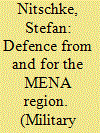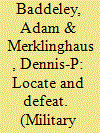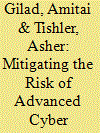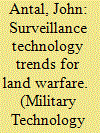| Srl | Item |
| 1 |
ID:
130305


|
|
|
|
|
| Publication |
2013.
|
| Summary/Abstract |
The article focuses on the development of various airborne sensors for military missions in Middle East and North Africa (MENA) regions. It says that synthetic aperture radar (SAR), active electronically scanned array (AESA), and forward looking infrared (FLIR) are associated with bringing information to the military. It mentions that the most common way in acquiring high-resolution imagery from a battlefield is airborne reconnaissance.
|
|
|
|
|
|
|
|
|
|
|
|
|
|
|
|
| 2 |
ID:
123926


|
|
|
|
|
| Publication |
2013.
|
| Summary/Abstract |
The article offers information on gunshot location systems with acoustic sensors to detect gunshots in an urban environment. It discusses how the system works which usually consists of microphones or sensors, a processing unit, and a user-interface displaying gunfire alerts. It details how the system locates gunshots and detect snipers. It also provides information on several gunshot location solutions which includes the Soldier Worn Acoustic Targeting System from Cobham PLC.
|
|
|
|
|
|
|
|
|
|
|
|
|
|
|
|
| 3 |
ID:
192046


|
|
|
|
|
| Summary/Abstract |
Modern countries employ computer networks that manage organizations in the private and public sectors. Cyber-attacks aim to disrupt, block, delete, manipulate or steal the data held in these networks, which challenge these countries’ national security. Consequently, cybersecurity programs must be developed to protect these networks from cyber-attacks in a manner that is similar to operations against terrorism. This study presents several models that analyze a contest between a network operator (defender) that deploys costly detectors to protect the network and a capable cyber attacker. Generally, when the deployed detectors become more potent or the defender exhibits higher vigilance, the attacker allocates more resources to R&D to ensure that the attack remains covert. We show that detectors may be substitutes, complements, or even degrade each other, implying that defenders must account for the cyber weapons’ characteristics and the attacker’s profile and strategic behavior. We derive the optimal number of detectors when the attacker’s R&D process features R&D spillovers and show that targeted detectors act as deterrents against high-quality weapons only if the attacker’s budget is not substantial. Finally, we demonstrate that common cybersecurity practices may be detrimental from a social-welfare perspective by enhancing an arms race with the attacker.
|
|
|
|
|
|
|
|
|
|
|
|
|
|
|
|
| 4 |
ID:
070848


|
|
|
|
|
| Publication |
Santa Monica, Rand Corporation, 2000.
|
| Description |
xiv, 66p.
|
| Standard Number |
0833027247
|
|
|
|
|
|
|
|
|
|
|
|
Copies: C:2/I:0,R:0,Q:0
Circulation
| Accession# | Call# | Current Location | Status | Policy | Location |
| 044318 | 358.170973/MAT 044318 | Main | On Shelf | General | |
| 044451 | 358.170973/MAT 044451 | Main | On Shelf | General | |
|
|
|
|
| 5 |
ID:
123916


|
|
|
|
|
| Publication |
2013.
|
| Summary/Abstract |
The article explores the trends in surveillance technology for land combat which are categorised as on-demand, enduring and persistent. These trends include small robots and throwbots that provide the ability to see a structure over a wall, old technologies in the form of high technological balloons, and wireless network of micro-mechanical systems. It notes that technological innovations including the proliferation of sensors may change nations' combat capabilities by 2020.
|
|
|
|
|
|
|
|
|
|
|
|
|
|
|
|